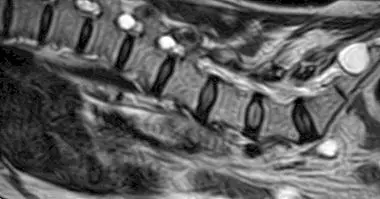Angelman syndrome: causes, symptoms and treatment
Angelman syndrome is a neurological disorder of genetic origin that affects the nervous system and causes severe physical and intellectual disability. People who suffer from it can have a normal life expectancy; however, they need special care.
In this article we will talk about this syndrome and will delve into its characteristics, its causes and its treatment.
- Related article: "The 10 most frequent neurological disorders"
Characteristics of Angelman syndrome
It was Harry Angelman in 1965, a British pediatrician, who described this syndrome for the first time, as he observed several cases of children with unique characteristics. First, this neurological disorder received the name "Happy doll syndrome" , because the symptomatology developed by these children is characterized by excessive laughter and a strange walk, with arms raised.
However, the inability to develop language or mobility correctly These are serious problems that develop individuals with Angelman syndrome, which was not named until 1982, when William and Jaime Frías coined the term for the first time.
Early development of this condition
The symptoms of Angelman syndrome are usually not evident at birth, and although the children usually begin to show signs of developmental delay around 6-12 months, it is not diagnosed until 2-5 years of age , when the characteristics of this syndrome become more evident. At very young ages, children may be unable to sit unsupported or do not stammer, but later, as they grow up, they may not speak at all or just be able to say a few words.
Now, most children with Angelman syndrome they are able to communicate through gestures , signs or other systems with the correct treatment.
Your symptoms in childhood
The mobility of a child with Angelman syndrome will also be affected. They may have difficulty walking due to problems of balance and coordination . Your arms may shake or move abruptly, and your legs may be stiffer than normal.
A series of distinctive behaviors they are associated with Angelman syndrome. At early ages, these children present:
- Laughter and frequent smile, often with little encouragement. Also an easy excitement.
- Hyperactivity and restlessness
- Short attention span
- Problems sleeping and need more sleep than other children.
- A particular fascination with water.
- Around two years of age, sunken eyes, wide mouth with protruding tongue and scattered teeth, and microcephaly.
- Children with Angelman syndrome may also begin to have seizures around this age.
Other possible characteristics of the syndrome include :
- Tendency to take out the language.
- Crossed eyes (strabismus).
- Pale skin and light colored hair and eyes in some cases.
- A side-to-side curvature of the spine (scoliosis).
- Walk with arms in the air.
- Some young babies with Angelman syndrome may have trouble feeding because they are unable to coordinate sucking and swallowing.
Symptoms in adulthood
With adulthood, the symptoms are similar; but nevertheless, seizures usually remit and even cease , and hyperactivity and insomnia increase. The aforementioned facial aspects remain recognizable but many of these adults have a remarkably youthful appearance for their age.
Puberty and menstruation appear at a normal age and sexual development is complete. Most adults are able to eat normally, with fork and spoon. Your life expectancy does not diminish , although women with this syndrome have a tendency to obesity.
The genetic alteration as a cause
Angelman syndrome is a genetic disorder caused by the lack of the UBE3A gene on chromosome 15q. This can happen mainly for two reasons. 70% of patients suffer a chromosomal alteration of 15q11-13 due to maternal inheritance, which is also responsible for a worse prognosis.
Other times it is possible to find uniparental disomy, by inheriting 2 chromosomes 15 from the father, which cause mutations of the UBE3A gene. This gene intervenes in the encryption of the GABA receptor subunits, causing alterations in the inhibitory system of the brain.
- You can know more about this neurotransmitter in this article: "GABA (neurotransmitter): what it is and what role it plays in the brain"
Diagnosis of the syndrome
It is necessary to be careful with the diagnosis of this syndrome that can be confused with autism due to the similarity of symptoms. However, a child with Angelman syndrome is highly sociable, unlike a child with autism .
Angelman syndrome can also be confused with Rett syndrome, Lennox-Gastaut syndrome and non-specific cerebral palsy. The diagnosis includes the verification of clinical and neuropsychological characteristics, and it is almost essential to carry out DNA tests.
The clinical and neuropsychological evaluation it is characterized by the exploration of functional areas of the affected people: motor tone, motor inhibition, attention, reflexes, memory and learning, language and motor skills, as well as executive functions, praxias and gnosias and vestibular function, related to balance and spatial function.
Multidisciplinary intervention
The Angelman syndrome is not cured, but it is possible to intervene and treat the patient so that he can improve his quality of life and encourage their development, so it is vital to provide individualized support. In this process a multidisciplinary team intervenes in which psychologists, physiotherapists, pediatricians, occupational therapists and speech therapists participate.
Treatment begins when patients are a few years old, and may include:
- Behavior therapy It can be used to overcome problematic behaviors, hyperactivity or short attention span.
- Speech therapists may be needed to help them develop non-verbal language skills , such as sign language and the use of visual aids.
- Physiotherapy can help improve posture , balance and the ability to walk.
When it comes to better regulating movements, activities such as swimming, horse riding and music therapy have shown their benefits. In some cases, an orthopedic device or surgery in the spine it may be required to prevent it from curving further.



















